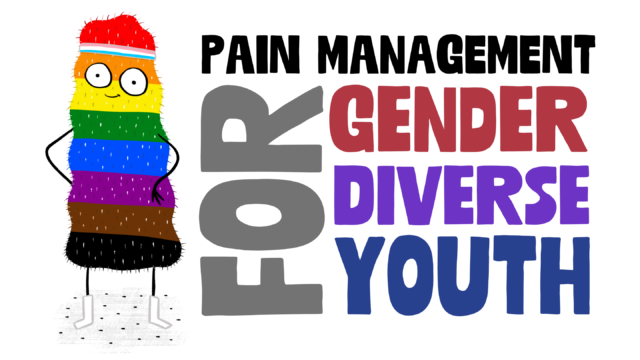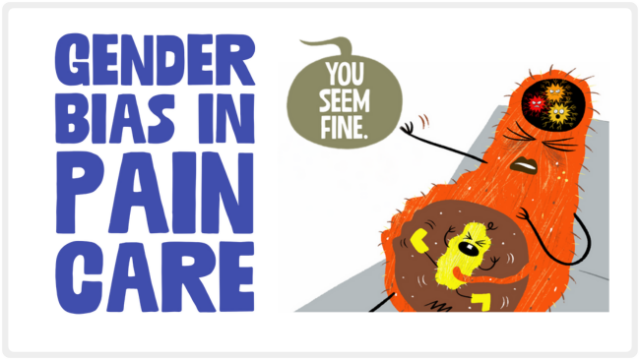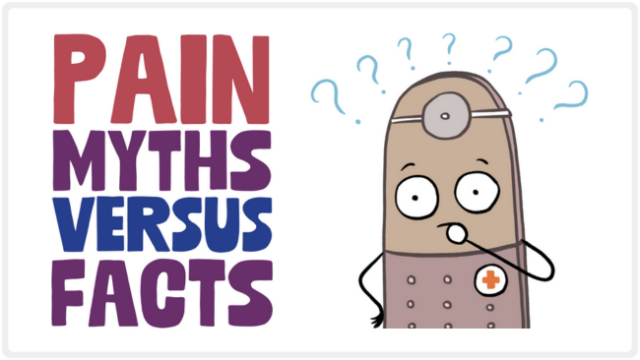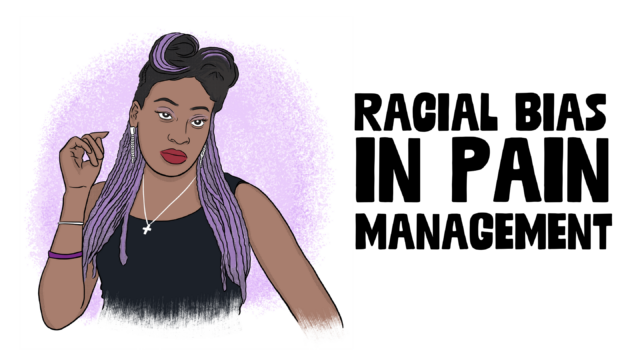Pain in the…chest? Strategies to manage the pain and discomfort of chest binding
For transgender and gender-diverse people, chest binding can affirm identity and boost confidence, but it can also cause pain. Discover safe practices and tips to ease chest binding pain.
Afiya Sajwani and Katelynn Boerner
Tweens & Teens (12+) Provider Acute Pain Chronic Pain English
Share this:

Let’s talk about chest binding
Many transgender and gender diverse (TGD) people regularly bind their chests. Chest binding, or binding, is a method of compressing chest (or breast) tissue to create the look of a flatter chest. It is a common and powerful way for TGD individuals who were designated female at birth or who have chest tissue to affirm their gender identity.
For TGD individuals, binding has many benefits¹. Binding helps them align their physical appearance with their internal sense of self. It provides a reversible way for TGD people to manage the distress related to their chest, and helps with any negative feelings about their body. Binding can have a positive impact on mental health. It can increase confidence and self-esteem, especially when interacting with others or doing their usual activities.
Balancing the good with the challenging
Although chest binding has tons of benefits for TGD individuals, it can also cause pain. In a study of 1,800 TGD people who bound their chests, around 75% of participants reported feeling pain². Experiences of pain can begin quickly after starting binding and may include pain in the back, shoulder, chest, and abdomen³. Muscular pain and skin irritation is also common.
Despite the possible side effects of binding, the mental health benefits often outweigh the risks of not having this way to affirm one’s gender identity. The good news is that there are safe ways to bind and reduce risk of pain, but not everyone knows about them. We are here to help! We bring you useful tips for both those who bind and the people who care for them!
Pro tips for those who bind
- Find a binder that you like! Binders look like tank tops and come in different styles. There are many online stores that sell binders – check out the resources below for some links. You can also think about finding a local clothing swap or a binder exchange program to try on a few different styles.
- Make sure your binder fits well. If the binder is limiting your breathing or movement, it is not the right fit. Follow the measurement guide from the manufacturer or retailer. Don’t be afraid to ask them questions about sizing!
- Avoid using elastic bandages, plastic wrap, duct tape and other such products for binding. These products are not designed for chest binding and can cause injuries.
- Keep your skin clean and dry under the binder to avoid rashes and infections.
- Try to limit binding to no more than 8 hours at a time. If this is not possible for you, give yourself breaks during the day, even for a few minutes! Breaks can be a great way to manage pain symptoms. It can be helpful to work with someone you trust to plan for when and how you might give yourself a break from binding during your day.
- Take off your binder before going to sleep. This is because our bodies need lots of oxygen when we sleep, and binding can restrict airflow.
- Wash your binder regularly and let it air dry.
- Squeeze in “off” days from binding each week. “Off” days can help with managing the pain that is common with regular and long-term binding.
- On “off” days, consider other ways to create the look of a flatter chest. Options include wearing loose fitting clothes with a sports bra or using Trans Tape or kinesiology tape (an elastic cotton strip with an acrylic adhesive that can be applied over the chest for coverage and flattening). Not sure where to start? Healthybinding.com can be a good place to explore options.
- Ask your doctors and trusted adults about any symptoms you might notice as a result of binding, including pain, rashes, breathing problems, etc. Don’t let symptoms get too bad before you ask for help.
- Learn exercises and stretches to decrease binding-related pain and discomfort. Medical professionals like physical therapists can help, and you can check out this video for some ideas.
How healthcare providers can help
- Respect youths’ privacy and comfort level in talking about binding, especially if the young person’s gender identity has not been shared with their parents.
- Keep in mind that binding is not associated with any particular gender identity, so you can’t assume whether someone binds or not based on their gender identity or expression.
- Understand potential barriers to safe binding. For example, youth who are not out to their family or who have fewer financial means might not have access to safe binding materials.
- Know about resources on safe binding, and access to local programs that can support TGD individuals in accessing binders and resources. See below for some great resources you can pass along, including PointOfPride.org.
- Understand that binding may facilitate functioning for youth by helping them feel more comfortable in spaces like school, doing sports, etc.
- Know that lack of access to chest binding can also result in pain if youth are hunching over to hide their chest.
- Do what you can to make the encounter a safe, affirming, respectful space for all young people, regardless of gender identity. Research has shown that TGD individual’s willingness to seek care is associated with feeling safe and being comfortable having a conversation about chest binding with a provider⁴.
Helpful Chest Binding Resources
- Trans Care BC Binding Handout: Created by Trans Care BC, this handout provides comprehensive information on safe binding practices.
- Trans Care BC Binding, Packing, Tucking, and Padding Guide: Another resource from Trans Care BC, this guide covers various gender-affirming techniques, including binding.
- Scarleteen Guide to Gender Expression Gear: Created by Scarleteen, this guide offers practical advice on various gender expression tools and accessories.
- QMUNITY I Heart My Chest Booklet: This booklet from QMUNITY provides detailed information on chest health and safe binding practices.
- Healthy Binding Guide: Developed by HealthyBinding.com, this guide offers extensive advice on how to bind safely and manage any associated discomfort.
- Chest Binding Video Guide: A video created by a trusted source, providing visual guidance on safe binding practices.
References
- 1. Pehlivanidis, S. G., & Anderson, J. R. (2024). A qualitative exploration of the motivations and implications of chest binding practices for transmasculine Australians. International Journal of Transgender Health, 1–14. https://doi.org/10.1080/26895269.2024.2319792
- 2. Peitzmeier, S., Gardner, I., Weinand, J., Corbet, A., & Acevedo, K. (2016). Health impact of chest binding among transgender adults: A community-engaged, cross-sectional study. Culture, Health & Sexuality, 19(1), 64–75. https://doi.org/10.1080/13691058.2016.1191675
- 3. Peitzmeier, S. M., Silberholz, J., Gardner, I. H., Weinand, J., & Acevedo, K. (2021). Time to first onset of chest binding–related symptoms in transgender youth. Pediatrics, 147(3).
- 4. Jarrett, B. A., Corbet, A. L., Gardner, I. H., Weinand, J. D., & Peitzmeier, S. M. (2018). Chest binding and care seeking among transmasculine adults: A cross-sectional study. Transgender Health, 3(1), 170-178.
You may also be interested in

Blog Post
Pain Management for Trans and Gender Diverse Youth
At Meg Foundation, we’re all about empowering children and families with resources that will help them be more comfortable and less anxious during medical procedures. For trans and gender diverse youth, the word “empowerment” is a critical part of their medical vocabulary.

Blog Post
"But You Look Fine…": Gender Bias And Pain Care
Dr. Grace Kao's personal account (backed by powerful research) highlights how gender and bias play out when it comes to treating women's pain.

Blog Post
Pain Myths And Facts: How Bad Information Hurts Us All (Literally…)
Knowing the facts instead of the misconceptions can open up opportunities to avoid a whole lot of unnecessary suffering, for you, for your family (and for your patients if you are one of those amazing healthcare providers we love!).
About the Author
Afiya Sajwani (they/them) is a Clinical Psychology doctoral student at Northwestern University Feinberg School of Medicine. Their research interests are in promoting positive mental and physical health outcomes among transgender and gender diverse youth. Clinically, they are interested in pediatric psychology. Currently, Afiya is on the leadership committee as the student representative for the Society of Pediatric Psychology’s Gender Health Special Interest Group.
Katelynn Boerner (she/her) is an investigator at the BC Children’s Hospital Research Institute (BCCHR) and assistant professor in the department of pediatrics at the University of British Columbia (UBC). As a registered psychologist, she is interested in increasing equity and access to care for young people who live with pain. Her research specifically focuses on the pain experiences of gender- and neuro-diverse young people. Dr. Boerner is the Research Chair of the Society of Pediatric Psychology’s Gender Health Special Interest Group.
